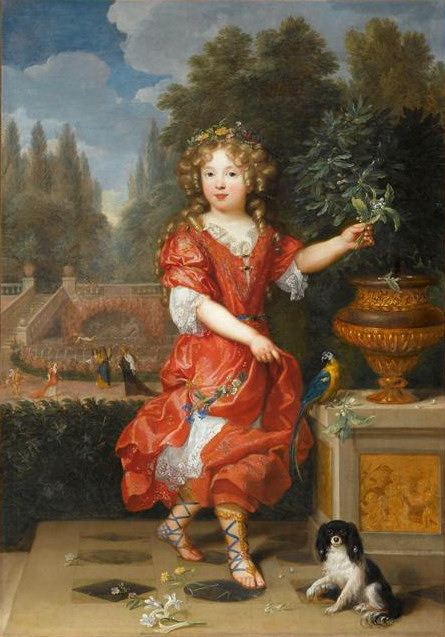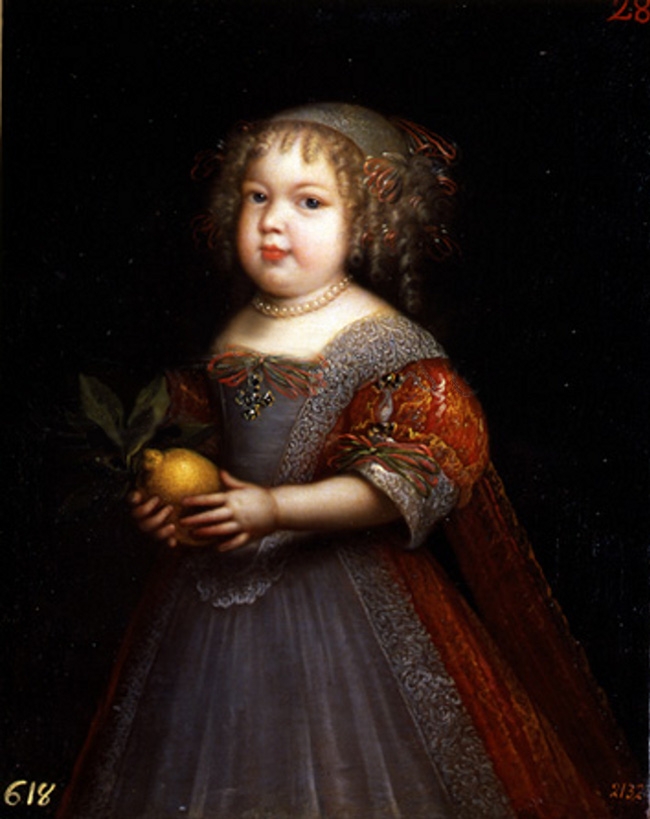Marie-Anne de Bourbon, Princesse de Conti
Born on 2 October 1666 to Louis XIV and his mistress Louise de La Vallière, Marie-Anne was immediately taken out of the arms of her mother and trusted into those of Marie Charron, the wife of Finance Minister Jean-Baptiste Colbert. Like her birth, this transition happened in total secrecy.

Marie-Anne was the fourth child of the couple, but all her siblings, three boys, died early. Born in secret and taken away in secret, she spent the first few months in secret as well. Far away from all the intrigues of the court, where her mother was fighting with her declining favour and torn between wanting to regain Louis XIV’s interest and retiring to a convent, in order to repent. Repent for her sinful life as mistress and the children born during it.
On May 13 in 1667, Louis XIV created a new Duchy. It was meant to be a sort of farewell gift for Louise de La Vallière. Her family owned the seigneurie de La Vallière since the time of her great-grandfather and Louis elevated this seigneurie to the status of Duchy. Louise received her gift the next day and along with it, Marie-Anne was legitimised. As fille légitimée de France, she was granted the surname de Bourbon and henceforth styled Mademoiselle de Blois, another new creation of her father.
Half a year later, Louise gave birth to another child. A boy named Louis. He was given into the care of Madame Colbert as well and grew up together with his sister.
Marie-Anne was presented to the court in 1674. At this time, her mother was still as court, but very firm in her decision to leave it as soon as possible. The introduction of Mademoiselle de Blois was a full success and everyone was immediately in love with the pretty little girl. The Sun King was rather pleased about it and so was his new mistress Madame de Montespan. Both hoped that if Louise sees her daughter so well received and admired, it might make her reconsider things. After all, if Louise really left, there was nobody to act as decoy to hide Louis’ affair with la Montespan. But Louise was not swayed. Not even at the thought of being a mother to her daughter and son, who were now allowed to visit court. She considered their birth to be a sin.
Louise remained firm and Louis saw that the only thing that still kept her at court, was his lack of permission to allow her to leave. After long years of struggle, he granted her permission. Louise gave up all her worldly possessions and titles. The Duchy especially created for her, went to her two children. Nevertheless, Marie-Anne always remained close to her mother and visited her often in the convent. She was just as close to her little brother, who was given into the care of Monsieur and his second wife.

Being much-loved by her father, he planned to marry his favourite daughter as well as he could. For example, to Victor-Amédée II de Savoie, a sovereign prince, and a grandson of Christine de France, thus a cousin to Louis XIV. Victor declined politely. Although he was not in a too good political situation, and this marriage would have helped, he did not want to marry a bâtard. (He married a daughter of Monsieur instead.)
Marie-Anne was thirteen years old as she married. Her husband was not a Savoy, but a proper Bourbon, a prince du sang, a Conti. Louis-Armand de Bourbon, Prince de Conti, apparently fell in love with Mademoiselle de Blois the very second he saw her for the first time. Their marriage took place at Saint-Germain-en-Laye, with much splendour, on January 16 in 1680. With a dowry of one million livres, Marie-Anne was the first legitimised child of Louis XIV to marry into the ranks of the Princes of the Blood. Thus the whole thing caused a proper scandal…. and the wedding night wasn’t a success either. The groom was eighteen, the bride thirteen, and both of them had no idea what to do. Nobody really told them. The new Princesse de Conti fled the bed in despair and her husband swore he would never ever share the bed with a woman again. No children were born to them.
The story of the bride fleeing the groom amused all of Versailles. Some even claimed the bride rushed out, because she found the brother of the groom, the Prince de la Roche-sur-Yon, in the bed and not the actual groom. While Marie-Anne was charming, beautiful and smart, her husband was more of the pious sort, unattractive and owned a slight hunchback. He was in love with her, she not so much with him. One day, she amused all of court with tales of what a complete zero her hubby was at love-making. Leaving him humiliated and fed up. He turned to debaucheries, so much that Louis XIV had to get involved and order him to behave himself.
Three years into the marriage, Marie-Anne had to mourn the loss of her little brother. Louis de Bourbon involved himself in a scandal, after which he was sent to Flanders to redeem himself. He fell ill and, eager as he was to regain the love of his father, he refused to rest. Louis died aged sixteen, far away from home. His father and mother did not mourn him, but Marie-Anne was much affected by the loss of her only direct sibling.
 Another two years later, in 1685, Marie-Anne lost her husband as well. She fell ill with smallpox at the end of October. As the news reached her husband, who was in Hungary fighting the Turks, he rushed back to France at once to nurse his wife himself. Marie-Anne recovered, but her husband got the smallpox as well and died only a few days later, on November 9.
Another two years later, in 1685, Marie-Anne lost her husband as well. She fell ill with smallpox at the end of October. As the news reached her husband, who was in Hungary fighting the Turks, he rushed back to France at once to nurse his wife himself. Marie-Anne recovered, but her husband got the smallpox as well and died only a few days later, on November 9.
Upon his death, the title of Prince de Conti went to his younger brother François-Louis. Marie-Anne did not marry again. She preferred to be free and even refused a marriage proposal from the the Sultan of Morocco. The new Prince de Conti married Marie-Thérèse de Bourbon and to distinguish between the old and the new Princesse de Conti, Marie-Anne was known as Madame la Princesse de Conti Douairière after her husband’s demise.
While Marie-Anne was one of the most important women at court for a long time, this changed as well in 1685. Her younger half-sister Louise-Françoise de Bourbon, legitimised daughter of Louis XIV and Madame de Montespan, married the heir of the Prince de Condé. Since the Condés outranked the Contis, Marie-Anne now had to pay the respects to her younger sister, which this younger sister had to pay her until this very point. Something that irked her greatly and created some tension between both of them. Then, in 1692, another sister married. Marie-Anne’s half-sister, Louise-Françoise’s full-sister, married the heir of Louis XIV’s brother. Being married to a grandchild of France, elevated Françoise-Marie de Bourbon to a rank above both her sisters… and she did flaunt that whenever she could. Enraging both of them alike.
Etiquette is a complicated thing, but Marie-Anne won in one department. Since her mother was unmarried, she was named as mother in the documents of legitimisation. While in the documents regarding the legitimisation of Madame de Montespan’s children by Louis XIV, the mother could not be named, due to her being married. This enabled Marie-Anne to sign as légitimée de France, something the Montespan daughters could not do. It also allowed her to mourn her mother in public upon her demise in 1710. Something the daughter’s of Madame de Montespan were also not allowed to do as their mother died in 1707.
Madame la Princesse de Conti Douairière could live a quite comfortable life. She had enough money at her disposal, the freedom to pretty much do what she wants, and a loving papa. She involved herself in various intrigues, fell in love with a poor Chevalier, and, after the death of Louis XIV, was put into charge of the education of Louis XV’s bride, Infanta Marie-Anne Victoire d’Espagne. She was sent to France, aged three, to marry Louis XV at some point, but the engagement was broken and the girl was sent back to Spain as she was seven. She became Queen of Portugal later on.
Marie-Anne died due to a brain tumour on 3 May 1739 and was buried at the église Saint-Roch in Paris.






One Comment
louikatorze
Some text mentions that she had lovers with both genders. Is there is more details about this?
Seems like she was also part of Meudon’s clique with his half sister La Duchesse de Bourbon and Monseigneur against the Orleans to influe on King’s decisions for weidings, but they failed because Madame de Maintenon were usually taking side of their enemy.